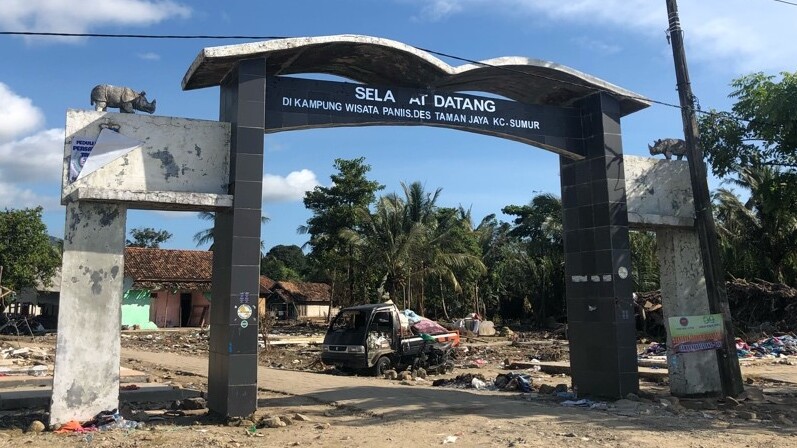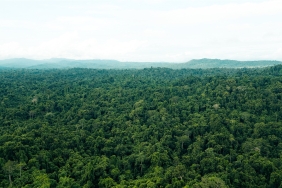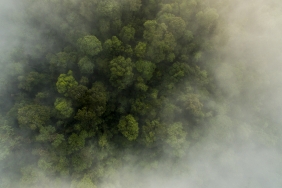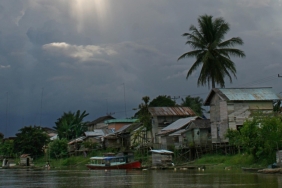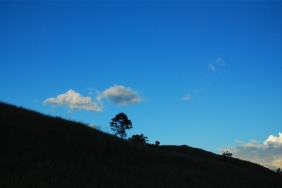THE RISE OF UJUNG KULON VILLAGE PEOPLE AFTER THE TSUNAMI
The tsunami that hit the Sunda Strait region on December 22, 2018, affected several areas in Banten and Lampung. Buffer villages located in the northern region of Ujung Kulon National Park (TNUK) were also affected by the tsunami caused by the activity of Mount Anak Krakatau.
As a result of the tsunami disaster, several houses of villagers located in the affected area suffered damage ranging from minor damage to heavy damage. The activities of community groups located in the affected areas were also hampered. There are three groups assisted by WWF Ujung Kulon, namely the Paniis Lestari Group (Panles), the Hanjuang Honey Group, and the Cinibung Wisata Group (Ciwisata) which were also affected by the tsunami at the end of December.
The Panles group is a group engaged in ecotourism located in Paniis Tourism Village, Taman Jaya Village, Pandeglang Regency, Banten. Paniis Tourism Village is one of the most severely affected villages. Approximately 42 houses were severely damaged and 106 families had to evacuate.
The group, which has been established since 2006, is active in tourism and conservation activities. Panles actively conducts coral reef transplantation activities. The Panles group was formed as a result of WWF Ujung Kulon's initiation together with the people of Taman Jaya village. In addition to marine tourism, the Panles group also often organizes cultural art performances during the harvest season by holding Pesta Rengkong.
Another community group that was also affected by the tsunami is the Hanjuang Group of Ujung Jaya Village. The activities of the Hanjuang group are different from the Panles group. The Hanjuang group is engaged in forest honey management. The group has also managed to develop a cooperative called the Hanjuang Cooperative. This cooperative handles the processing, packaging, distribution and marketing of the honey produced.
The last group that is also a WWF-assisted group is the Ciwisata (Cinibung Wisata) group located in Cinibung Village, Kertajaya Village. Cinibung Village is also one of the locations affected by the tsunami. Ciwisata group is engaged in handicrafts. This group consists of wood carving craftsmen. The type of carving they usually produce is wooden carvings of rhino statues. The Ciwisata group was formed in 2012. The rhino statue produced by the Ciwisata group can be used as a promotional tool for Javan rhino conservation. This group has handled several orders for rhino statue souvenirs.
After the tsunami, the three groups experienced a decline in activities. They also suffered losses caused by the tsunami. After the tsunami hit Paniis Village, the Panles Group's tourism activities were also affected. Some of the physical facilities owned by the Panles Group such as meeting and learning centers were washed away by the tsunami.
Equipment that supports coral reef transplantation activities such as diving equipment was also washed away by the tsunami. "Currently, the Panles Group together with the people of Paniis Village are still in the effort of psychological and infrastructure recovery after the tsunami disaster," said Doni, one of the Panles Group administrators. Doni also talked about the plan to build temporary shelters and permanent housing for Paniis residents who no longer have a place to live due to the tsunami.
Similar losses were also experienced by the Hanjuang Honey Group. Their honey storage warehouse was damaged by the tsunami and they lost approximately 4 quintals of honey. The loss of this large supply of honey affected their honey marketing activities. As explained by Anton, WWF staff and also the guide of the Hanjuang group, the Hanjuang Group has been actively marketing their honey to be supplied as one of the raw materials for the famous cosmetic brand, Oriflame. Given that they can only harvest honey during the dry season, of course the loss of a large stock of honey will have a considerable loss effect on the Hanjuang Group. After the tsunami, like Panles, the Hanjuang Honey Group has not been active in its activities. Currently, they are still recovering from the psychological impact of the tsunami. However, in the near future they will soon plan activities that can be carried out immediately by the group.
A similar situation was experienced by the Cinibung Village Tourism Group. "We lost equipment used to make rhinoceros statues such as wood shaving machines, we also lost some of the handicrafts we had made due to being swept away by the tsunami, if converted, our losses were around 10 million more," said Mardi, chairman of the Ciwisata Group. The lack of visitors after the disaster also made their handicraft business deserted from buyers. Although not as bad as Paniis Village, until now Cinibung Village is still in the recovery stage after the disaster. Like the other two groups, Ciwisata's art activities had stopped, but after the recovery stage after the disaster, they will start thinking about the activities that will be carried out by the group.
The WWF Ujung Kulon team, which has a historical relationship with the buffer villages around TNUK including the three village groups that are also in the buffer zone, feels a moral responsibility in terms of handling this tsunami disaster. Therefore, the WWF Ujung Kulon team took the initiative to establish a program called 'pekkerti', Participatory Vulnerability and Capacity Assessment in Disaster Risk Reduction Efforts.
The purpose of this program is to prepare villagers in disaster-prone areas and the WWF team itself to be able to deal with situations in the event of a disaster, not only tsunamis but various forms of disasters. It is expected that after this program the village can have its own procedures in disaster emergency response such as having clear gathering and evacuation points and can manage emergency supplies after a disaster. This program will actively involve the village community. Hopefully, the implementation of this program can encourage villages including these three groups to be more enthusiastic in doing activities for their villages.

